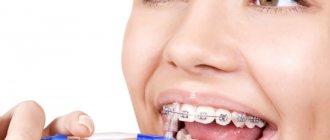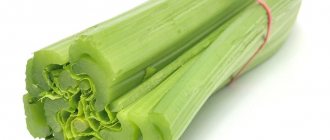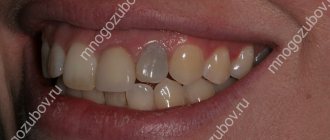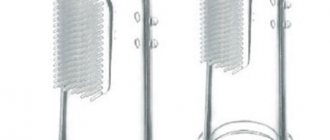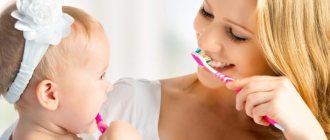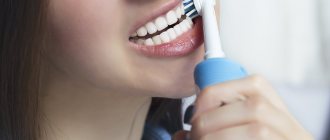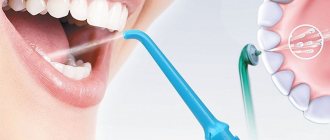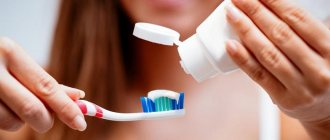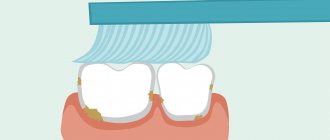How to say correctly: brush or brush your teeth?
Verbs form the imperative mood in different ways. For example, from the verb “cut” we form the imperative form “cut” with a zero ending, as well as hang - hang, throw away - throw away, uncork - uncork.
And for the verb “clean” this form will sound like “clean” with the ending -i.
Compare: catch - catch, guard - watchmen, carry - carry, bring - bring.
The forms of the imperative mood “look” (instead of look), “clean” (instead of clean), put (instead of put) are colloquial.
How to brush your teeth correctly.
To brush before or after breakfast, when to use dental floss and whether mouth rinses are necessary - dentists clarify.
It’s better before breakfast, but you can do it after
Science has not proven that bacteria that accumulate in the mouth overnight will cause any health problems. Therefore, brushing your teeth before breakfast is not necessary, but it is advisable. After all, if you think about it, eating with unbrushed teeth is almost like eating from a dirty plate.
The main thing is not to brush your teeth immediately after breakfast if you drank orange juice or something else sour. After coffee, yes. Acid from foods reacts with tooth enamel, so if you brush right away, you can cause minute damage to the enamel. Ideally, you should brush your teeth either before breakfast or half an hour after.
But don't worry too much if you brush your teeth after drinking juice. “It’s a question like, ‘How many angels can fit on the head of a needle?’” says dentist Grant Richey. “I don’t think I’ve ever seen a patient whose enamel was completely worn away from brushing his teeth after breakfast.”
In general, it is better to brush your teeth after breakfast than not to brush at all.
Preventive measures
It is easier to prevent the formation of plaque on the tongue than to treat its pathological form. The following preventive measures will help with this:
- Perform comprehensive oral hygiene morning and evening.
- Monitor the condition of the gastrointestinal tract and treat diseases of the digestive system in a timely manner. They are most often the cause of pathological plaque.
- Stop smoking and drinking alcohol.
- Consume spices, smoked and spicy foods in moderation.
- Treat caries and other dental diseases in a timely manner. Get preventive examinations at the dentist.
- Drink more and eat vegetables and fruits with a high fluid content, because dehydration can be the cause of plaque on the tongue.
Thus, brushing the tongue is an important part of oral care. It helps to avoid the problem of bad breath, reduces the risk of developing inflammation in the mouth and serves as a prevention of dental diseases. Plaque can be removed in different ways, including with a regular toothbrush. In addition, it is necessary to follow preventive measures to avoid the appearance of pathological plaque.
Dental floss - anytime
There is no consensus on when exactly to floss: before or after brushing. Dr. Ritchie himself does this during cleansing. But he emphasizes that this is not a prerequisite.
"As long as you brush your teeth twice a day with fluoride toothpaste and use floss or other interdental cleaning products, you shouldn't have to worry," says Alice Boghosian, a spokeswoman for the American Dental Association. - Do as you feel comfortable. The main thing is to clean the spaces between your teeth every day.”
In Ozhegov's dictionary
CLEAN, clean, clean; cleaned; nesov. 1. someone or something. Removing dirt, whatever. layering, make clean. Ch. dress, shoes, dishes. Part of the horse, part of the teeth. Bird cleaning its feathers. 2. what. When preparing food, remove peels, scales, shells, seeds (in 2 digits) from vegetables, fish, berries, mushrooms. 3. what. Free from something. accumulated, polluting. Ch. garden, paths, pond. 4. what. Remove (what clogs, pollutes, clutters). There is snow on the tracks. Ch. Dirt from shoes. Ch. rubble. 5. someone or something. Rob, rob (simple). Ch. cash register. || owls clean, - looking, - clean; -sought (to 1 and 3 meanings), purify, -searching, -istish; -searched (to 2, 3 and 5 meanings) and clean, -searching, -istish; -searched (to 1, 2 and 3 values). 1G noun cleaning, -i, g. (to 1, 2, 3 and 4 values), chnshchenie, -i, cf. (to 1 and 2 values) and cleaning, -i, g. (to 2 and 4 values). || adj. cleansing, -th, -oe (to the 1st and 4th stages; special).
Rinse optional
According to Bogozien, mouthwash is not necessary for dental health. Most are simply designed to make your breath smell good. Use such products last, then the feeling of freshness will last longer.
Some mouth rinses are designed to target specific problems, such as killing germs in the mouth. It is better to use such remedies as prescribed by a doctor. Fluoride rinses strengthen enamel. Use them as the final step in your dental care to ensure that fluoride stays on your teeth for as long as possible.
If you're at all wondering how to properly brush your teeth, you're fine. Those who do not brush their teeth regularly should be concerned.
How to brush your teeth correctly.
For many people, brushing their teeth has become so routine that it is done automatically. Unfortunately, dentists note that not everyone knows how to do this efficiently. Food particles remain in the mouth, a persistent plaque forms, and an unpleasant odor is felt by others when talking. Poor hygiene is one of the causes of caries, painful pulpitis and gingivitis. Simple and understandable recommendations from doctors will help you learn how to brush your teeth correctly and avoid serious complications.
Correct brush direction when brushing
Review and detailed analysis of all stages of comprehensive teeth cleaning
Professional teeth cleaning is a process of several stages, using certain technologies. Initially, the hygienist removes deposits that have hardened and formed a special stone on the teeth. Such deposits can be eliminated through the use of ultrasonic equipment.
Ultrasonic teeth cleaning
Tartar is hardened (or mineralized, in more professional terms) deposits on certain areas of the tooth.
Based on the area of formation, tartar is divided into supragingival and subgingival. The second type poses the greatest danger to humans, since it very often leads to gum inflammation in the future. Simple methods cannot get rid of such deposits, and only the use of ultrasonic equipment can eliminate them.
When performing cleaning, ultrasonic waves destroy deposits even in the most difficult to reach areas, and at the same time harmful microflora, which can lead to inflammation. Timely use of teeth cleaning will help avoid various dental problems. Such as, for example, periodontitis or periodontal disease.
Dentists use a special device (scaler) to solve these problems. It creates the necessary ultrasonic waves. It has a tip with a special attachment that transmits waves to the areas that need to be treated. It is also supplied with water or antiseptic. The dentist, using the device, can change the intensity of vibrations, selecting the most suitable mode for the patient.
How is tartar removed?
When performing such cleaning, it is destroyed due to the following:
- Ultrasound has a mechanical effect on hardened areas. The waves gently crush the stone into small pieces, which are easily removed with water or a special vacuum cleaner for the oral cavity;
- The simultaneous supply of liquid and ultrasound leads to the formation of a cavitation effect, during which a huge number of microbubbles are created. They blur plaque and speed up its separation from the tooth surface.
Important! Before it became possible to use ultrasound, tartar was removed exclusively with hand tools. Because of this, the procedure was very long and complicated. The dentist could easily injure the soft tissues, since the instrument used was extremely sharp, so the whole procedure could hardly be called pleasant. The most negative point in all this was that during the procedure, tooth enamel was significantly damaged. This was due to the fact that to remove plaque it was necessary to remove a layer of healthy tissue. After performing this type of cleaning, patients often experienced unpleasant dental hypersensitivity. The use of ultrasound allows you to avoid all these problems. Ultrasonic cleaning is absolutely safe; it does not injure the gums or mucous membranes.
It is very important that all procedures are carried out using modern equipment, without any disruptions in the process, only then the cleaning will be carried out professionally and will be safe. To do this, it is important that the hygienist has experience working with a scaler: the tip of the device should move only along areas of the tooth at a specific angle, and the cleaning itself should be accompanied by a significant supply of water to the teeth. It is very important to follow this process technology, since violations can damage the enamel or overheat the pulp, which can lead to various complications.
Our dental clinic carries out such cleaning only under the guidance of professional hygienists, as well as using modern equipment, so patients have nothing to fear and are guaranteed an impeccable result.
Important! A positive feature of using ultrasound, as opposed to other types of cleaning (with the exception of laser cleaning), is that it kills pathogenic microflora. For this reason, this procedure is highly recommended for patients with gum disease, because ultrasound kills pathogenic microflora in all areas, including periodontal pockets.
You should not be afraid of such cleaning, because it does not cause pain at all. If you are concerned that they may occur, you can ask the hygienist to pre-administer anesthesia. With this option there will definitely be no pain. Otherwise, ultrasonic cleaning is very fast. Up to 60 minutes, the exact time depends on how much deposits are observed in the oral area.
Important! If you have hypersensitivity or have a lot of deposits in the subgingival pockets, then there may be some pain during ultrasonic cleaning, and this is normal. In order to remove them, you need to administer anesthesia before cleaning. It can be administered not by injection, but by applying a local application. Therefore, there is no need to be afraid or panic.
Once this stage has been successfully completed, the hygienist moves on to the next stage and performs cleaning using Air Flow technology.
2.Air Flow
During the Air Flow teeth cleaning procedure, a special sandblasting device is used, which, using air and water, delivers a composition with abrasive particles to the enamel surface. The liquid is supplied in a powerful stream, which allows you to cleanse your teeth of bacteria and plaque in a short period of time. This method is effective not only for removing loose deposits, but also pigmented plaque that is firmly embedded in the enamel.
Air Flow is an innovative technology for cleaning teeth, which has a number of undeniable advantages:
- Air Flow easily fights plaque located in hard-to-reach areas of the oral cavity, which helps get rid of bad breath.
- The procedure can be performed without the use of anesthesia. It does not cause pain or discomfort. Mild pain may occur in patients with hypersensitivity.
- During the Air Flow procedure, aromatic liquids are used that can give freshness to your breath and turn cleaning into a pleasant, painless process.
- In liquids for the Air Flow procedure, soda is used, crushed to a powder state. This means that the risk of injury to tooth enamel during the cleaning process is completely eliminated.
- Air Flow effectively removes pigmented plaque. The procedure is indispensable for smokers and lovers of strong coffee and black tea. Excessive consumption of coffee and tobacco negatively affects the whiteness of the enamel, making it yellow. Air Flow quickly removes unpleasant plaque, restoring your teeth to their attractive appearance.
- During cleaning, do not use liquids with caustic chemical composition. This means that cleaning is safe and does not cause allergic reactions or other unpleasant consequences.
- The air-abrasive flow helps restore teeth to their natural white color and make your smile more attractive.
IMPORTANT: Using Air Flow technology, the doctor independently adjusts the power of the water-air flow onto the enamel surface, taking into account the individual characteristics of the patient’s teeth. The dentist takes into account the structure and condition of the enamel and whether there is hypersensitivity. This approach helps to achieve high efficiency and complete safety for patients.
Why does professional cleaning combine two techniques - Air Flow and ultrasound?
This question worries many patients. Hygienists explain that only a combination of two cleanings can achieve the desired result and carry out the procedure for cleansing the oral cavity from bacterial plaque at the proper level.
Air Flow cleaning works great at removing pigmented plaque that has become embedded in the pores of the enamel, but it will not be able to remove hard tartar, and is ineffective in the presence of mineralized deposits located in periodontal pockets.
Ultrasonic cleaning works well to remove tartar, but the metal tip of the scaler cannot penetrate the space between teeth (it is especially difficult to clean the interdental space in patients whose teeth are too close together). That is why these methods are used in combination. During professional cleaning, ultrasound and Air Flow methods are used.
IMPORTANT: Air Flow and ultrasonic cleaning can lighten tooth enamel to a natural level - by 2 tones. For those who want to achieve a more pronounced effect, after cleaning they should resort to a professional whitening procedure.
Teeth polishing is one of the mandatory stages of professional cleaning.
The third stage of brushing your teeth involves mandatory polishing of your teeth. Using polishing, the dentist eliminates all irregularities and microcracks in the enamel that form after cleaning the teeth of accumulated deposits. Professional teeth cleaning is impossible without polishing, since roughness will remain on the enamel, which promotes the adhesion of microparticles of food.
As a result, a layer of plaque forms again, which subsequently mineralizes and turns into tartar. Teeth polishing carried out after professional cleaning significantly slows down the process of plaque formation and keeps teeth shiny and smooth for a long time.
Teeth polishing after brushing is carried out using a special tool with several replaceable attachments. Each of them performs a specific task:
- Needle-shaped attachments are used to grind the surfaces of teeth and the gingival zone;
- Brushes help remove remaining plaque particles from rough areas of teeth;
- Crowns and dentures made of different materials are processed with different types of polishers;
- Discs allow you to give ideal smoothness and shine to cleaned teeth.
Treatment of interdental spaces after professional cleaning is carried out using special strips, as they easily fit into the narrow space between the teeth.
The process of polishing teeth after professional cleaning involves the use of not only tools, but also several types of pastes with varying degrees of abrasiveness. In addition to abrasive particles, polishing pastes contain fluorine and xylitol, which are involved in strengthening teeth.
Stages of teeth polishing after professional cleaning
- Polishing the outer surface of teeth using tools and paste;
- The treatment of flat surfaces is followed by polishing the fissures (tubercles) of the chewing teeth;
- Polishing the spaces between teeth with strips.
The average duration of teeth polishing performed after professional cleaning is 30-40 minutes. This does not require anesthesia, since the process of polishing teeth is a painless procedure that does not cause discomfort to the patient. Upon completion of polishing, the oral cavity must be rinsed with water, after which the dentist carries out the final stage of professional teeth cleaning - fluoridation.
4. Fluoridation is the final stage of professional teeth cleaning
Fluoridation is not a mandatory procedure after professional teeth cleaning, but you should not refuse it, as it combats increased sensitivity of teeth, strengthens enamel and prevents the occurrence of caries. Fluoridation involves treating tooth surfaces with fluorides.
Benefits of fluoridation:
- Normalizing the level of fluoride in the body, strengthening teeth and increasing the strength of enamel;
- Stops the process of leaching calcium, which is so important for dental health;
- Slowing down the proliferation of pathogenic bacteria in the oral cavity and the formation of plaque.
The process of fluoridation of teeth occurs as follows: the teeth are dried with an air stream directed at them. Next, using trays or a brush, a solution enriched with useful substances is applied to each tooth. Fluoridation is the final stage of professional teeth cleaning. But after the procedure, every dentist will definitely give recommendations on proper care of your teeth and oral cavity.
Why is it important to maintain dental hygiene?
When chewing food, microscopic fibers inevitably remain in the mouth, which linger in the interdental spaces and stick to the enamel. This plaque is invisible to humans, but tightly covers the molars with a thin film. This creates an ideal environment for the proliferation of pathogenic microorganisms and fungi. An unpleasant picture is observed in people who brush their teeth quickly, not wanting to waste precious time on this procedure.
Caries is the most common disease if you don't brush your teeth.
This attitude will sooner or later come back to haunt the acid balance, which intensifies the erosion of thin enamel. This leads to the following problems:
In the dictionary Complete accentuated paradigm according to A. A. Zaliznya
clean, clean, clean, clean, clean, clean, clean, clean, cleaning, cleaned, cleaned, cleaned, cleaned, clean, clean, clean, clean, cleaning, cleaning, chi cleaning, cleaning, cleaning, cleaning, cleaning, cleaning, cleaning, cleaning, cleaning, cleaning, cleaning, cleaning, cleaning, cleaning, cleaning, cleaning, cleaning, cleaning, cleaning, cleaning, cleaning, cleaning, cleaning, chi cleaning, cleaning, cleaning, cleaning, cleaning, cleaning, cleaning, cleaning, cleaning, cleaned, cleaned, cleaned, cleaned, cleaned, cleaned, cleaned, cleaned, cleaned, cleaned, cleaned, cleaned, cleaned, cleaned, cleaned, cleaned, cleaned, cleaned lice, cleaned, cleaned, cleaned, cleaned, cleaned, cleaned, cleaned, cleaning, being cleaned, being cleaned, being cleaned, being cleaned, being cleaned, being cleaned, being cleaned, being cleaned, being cleaned, being cleaned, being cleaned, being cleaned, being cleaned, being cleaned, being cleaned, being cleaned, being cleaned, being cleaned, being cleaned, being cleaned, being cleaned, being cleaned, being cleaned, being cleaned, being cleaned, being cleaned, being cleaned, being cleaned, being cleaned, being cleaned, being cleaned, being cleaned, being cleaned, being cleaned, being cleaned, being cleaned, being cleaned, being cleaned, being cleaned, cleanable, being cleaned, being cleaned, being cleaned, being cleaned, being cleaned, being cleaned, being cleaned, being cleaned, being cleaned, being cleaned, being cleaned, being cleaned, being cleaned, being cleaned, being cleaned, being cleaned, being cleaned, being cleaned, being cleaned, being cleaned, being cleaned, being cleaned, being cleaned, being cleaned , being cleaned, being cleaned, being cleaned, being cleaned, being cleaned, cleaned, cleaned, cleaned, cleaned, cleaned, peeled, peeled, peeled, peeled, peeled, peeled, peeled, peeled, peeled, peeled, peeled, peeled, peeled, peeled, peeled, peeled, peeled, peeled, peeled no, cleaned, cleaned, cleaned, cleaned, cleaned, cleaned, cleaned, cleaned, cleaned, cleaned, cleaned, cleaned, cleaned, cleaned
Share the meaning of the word:
What should you brush your teeth with?
The vast majority of people do not pay much attention to the quality of the bristles or the presence of special inserts when they purchase a toothbrush at the store. However, manufacturers produce entire series that take into account the individual characteristics of a person’s enamel, bite and age. The most effective hygiene products have several rows of fibers of different lengths and hardness. This allows you to simultaneously remove plaque from the surface of the incisor and remove microparticles from the interdental spaces.
When choosing a toothbrush, you should follow certain rules in order to purchase the most effective and high-quality one:
- Do not buy products from unknown manufacturers: the materials may contain alloys and abrasive substances that are dangerous to the enamel, scratching it and damaging it.
- For healthy teeth, use medium-hard bristles. If sensitivity is impaired, it is better to pay attention to soft series with natural beams.
- A good brush contains a special rubber strip with a ribbed coating on the reverse side. It perfectly cleanses the surface of the tongue from the accumulation of bacteria, complementing the procedure for proper brushing of teeth.
Many patients are interested in modern electric brushes. The opinion of experts is ambiguous: they believe that using the device more than 2 times a week can thin the enamel. A safer option is ultrasonic innovations that work as gently and efficiently as possible. There is no need to know the secrets of how to brush your teeth correctly: plaque is quickly destroyed in all hard-to-reach places without any effort on the part of a person. But the too high cost of the product makes it inaccessible to the vast majority of people.
It is better to entrust the choice of toothpaste to a professional. To begin with, he will examine the oral cavity and identify “weak spots.” The dentist is not interested in the price or the advertised brand, but in the components. The quality of water for brushing teeth and cooking, saturation of the diet with vitamins and minerals is important. For caries or thinning enamel, the series with calcium and fluoride produced by Lakalut or New Pearl are more suitable. If there is looseness of the gums, it is better to use the therapeutic “Parodontax”. If the microflora is unstable, you should switch to antibacterial pastes.
In Efremova's dictionary
Emphasis: cleanse the nes. trans.
- Remove dust, dirt, etc. from something, to make clean; cleanse
- Apply gloss by polishing until shiny.
- To free from unnecessary, superfluous, preparing for smth.
- trans. decomposition To subject to examination in order to liberate or free oneself from harmful, unnecessary, alien elements, to separate the healthy from the unfit.
- To remove, cut off the peel, skin, scales from something. (fruits, vegetables, fish, etc.).
- Release fruits, grains, etc. from seeds, stems, litter.
How to brush your teeth correctly: useful tips
Rules for brushing teeth
For oral health, it is necessary to clean not only the enamel, but also all areas of the mucous membrane, paying attention to the inner surface of the gums, cheeks and tongue. Doctors recommend doing this carefully, paying attention to each interdental space. They give the following advice to their patients:
- movements should go without haste from top to bottom, as if sweeping food particles out;
- Do not move the brush horizontally, so as not to damage the neck of the tooth;
- it is held at an angle of 45°, which helps to easily reach all the plaque;
- the procedure begins with the back molars, leaving the front incisors for last;
- specially elongated bristles at the end of the brush clean all the gaps from the inside.
In the Dictionary of Synonyms
clean, clear, clear, sweep, brighten, scrape, wash, wash, rinse; filter, strain, settle, reduce (remove) stains; cleanse the Augean stables; to polish, to polish, to polish, to peel, to scold, to peel, to knock out, to scrape, to clear, to scrape out, to scratch, to scold abusively, to scold in the last words, to bastard, to clean off, to scold, to re-clean, to clean up, to wash, to brighten, to polish, to peel, to scold on what is worth, beat, tear, bone, peel, wax, shower with abuse, shower with curses, scrape, wipe, send away, call names, remove, remove, hit, scold, rob, lick, clean, scratch, lick, poke, cover , peel, rob, honor, peel, bake, cover, cleanse. Ant. pollute, pollute
Additional hygiene products
Experts recommend not limiting yourself to a regular toothbrush and toothpaste and using additional products daily (see photo) to maintain proper oral cleanliness. Among them are:
Dental floss (floss). Necessary to clean the spaces between teeth from plaque. Flosses are made from synthetic materials or silk. Dental floss can be regular or waxed. In the first case, it will be divided into several threads when brushing your teeth. They clean teeth better due to the larger contact area. Wax-coated threads do not separate and are able to easily penetrate between the contact surfaces of the teeth. They are recommended for children, as well as people who are just starting to use this hygiene product. In addition, flosses differ in cross-section, which can be round, ribbon, flat or voluminous. This variety allows you to individually choose dental floss based on the anatomical structure of each person’s dentition.
Irrigator. It is a special device that creates a thin stream of water under high pressure. This pressure is selected so as to effectively clean the surface of the teeth from plaque without injuring the soft tissues. On the contrary, the irrigator has a massage effect on the gums, relieves inflammation and eliminates bleeding. The device is indispensable for people who have braces or other bulky dental structures that are difficult to clean.
- Mouth rinses. Some people believe that the only purpose of mouthwashes is to freshen your breath. In fact, these hygiene products have a much wider spectrum of action. They may contain antiseptic and anti-inflammatory components, minerals, agents that help relieve bleeding gums, etc. Based on the set of these active substances, all rinses are divided into hygienic and therapeutic and prophylactic.
- Brushes and tongue scrapers. They help remove plaque and microorganisms from the surface of the tongue. For high-quality and complete oral hygiene, it must also be cleaned regularly. This procedure will be of particular benefit to patients who smoke, as well as those suffering from diseases of the upper gastrointestinal tract, accompanied by bad breath.
- Cleaners. These devices are designed both for cleaning interdental spaces and can be used for cleaning fixed dentures, orthodontic appliances, etc. They can be made in the shape of a cylinder or a cone. In addition, they differ in size. The service life of one such product is about 5 days.
- Dentifrice. It is a good preventative against caries. It has a polishing and whitening effect, helping to remove stains from tea, coffee, and cigarettes. The question is often asked: is it harmful to brush your teeth with tooth powder? There is only one answer: no, it is not harmful. The decline in its popularity occurred mainly as a result of a marketing policy focusing on the promotion of oral hygiene products (pastes, rinses) of large international companies.
- Chewing gum. It is an excellent solution for mechanical removal of food residues. At the same time, you need to know that you can chew gum only after eating for 10 minutes, no more. You also need to make sure that there is no sugar in its composition. Chewing gum should not be used by patients with phenylketonuria, children with baby teeth, during orthodontic treatment, pregnant women and nursing mothers.
Using a regular brush in combination with these products will allow you to better clean the oral cavity of plaque. For an unprepared person, such an abundance of hygiene products can lead to difficulties in choosing the most suitable ones. In such situations, it is necessary to contact a dentist who will select everything necessary for high-quality cleaning of the oral cavity, taking into account the characteristics of a particular patient.

